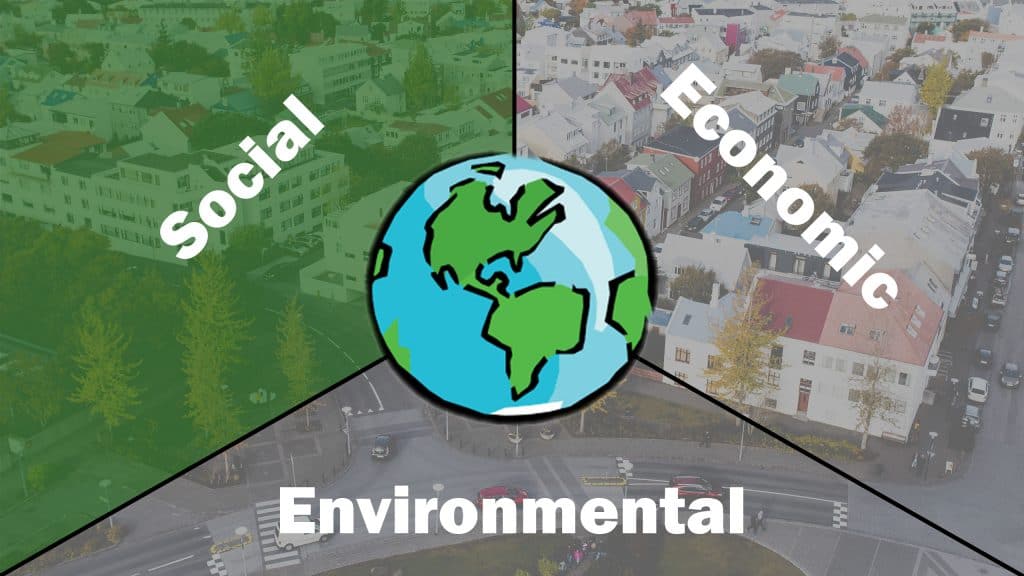
This is a guest article written by Utopia Experience. To learn more about their mission to be the world’s most innovative experience-creators (and find out how they’ve helped 200 nonprofits raise over $30 million in the last 3 years) visit utopiaexperience.com.
When people hear the word “social sustainability,” they’re likely to think of coordinated efforts to protect the environment.
Preventing pollution, reducing water use, cutting carbon emissions, etc. These are all important, good things, but in this article, we want to unpack one of the often overlooked elements of sustainability: social sustainability.
Social sustainability is one of the three interconnected dimensions of sustainability recognized by the United Nations, which they describe as being “about identifying and managing business impacts, both positive and negative, on people.” It’s a measure of the way an organization impacts the community it’s a part of. A business that damages the environment, or puts profit
over people’s safety and well-being, will eventually lose the trust and support of the community (including investors, customers, and partners). A business that conducts itself ethically, while working to give back to the community, will eventually gain the trust and support of the community.
This, often unspoken, acceptance is referred to as an organization’s social license to operate (SLO). Now, the good news is that most nonprofits work tirelessly to help improve the lives of individuals and the community in which they operate, thereby renewing their SLO. They serve the community and, in return, gain their trust and support. An important part of this effort, though, is visibility.
How to Remain Visible in a Sea of Noble Causes.
A critical part of any organization’s development strategy involves reaching more people, and nonprofits are no exception. More people being aware of your work and your mission will help you remain sustainable, not just socially, but economically, too. After all, you’re competing with other valuable nonprofits for limited resources and donor dollars. Can you stand out from the crowd? Remain economically viable in a sea of noble causes? Can you count on a consistent source of funding?
This is where the art and science of effective storytelling comes in. You want to draw attention to the great work you’re doing (since it’s such a key part of remaining socially and economically sustainable). Packing all of your organization’s efforts into a thoughtful, easy-to-digest story can be remarkably challenging. How do you share all of the incredible things your organization is doing in an interesting way?
Increasingly, Nonprofits are Turning to Video for Storytelling.
Video allows you to connect with potential donors in a more meaningful way than other, more traditional mediums. With engaging visuals, a compelling narrative, and thoughtful editing, you can tell your story in a way that sticks with people. One of the organizations we’ve seen do this most effectively is Variety the Children’s Charity.
“Variety Unbound,” their first live event since the pandemic, marked a notable departure from some of Variety’s tried and true traditions. An organization focused on the health, well-being, and dignity of children with disabilities. Variety wanted to showcase their work and recipients in a way that left attendees with a genuine connection to their mission. They embraced the power of video storytelling to do it. The evening was an incredible success, and you can watch a more detailed case study of what exactly made Variety Unbound so magical below.
As a nonprofit, you’re already doing the work in the world that matters.
The next step, then, is to share it—to continue renewing your SLO. Telling your story in a thoughtful way is critical to the overall long-term viability of your organization, and video is absolutely one of the best ways to do it.
Event software like Greater Giving helps nonprofits remain socially sustainable by allowing them to streamline their event planning process. No one of the dimensions of social sustainability is more important than the others, but we would be remiss not to highlight the opportunity Greater Giving provides for nonprofits. After all, economic sustainability is usually what’s top-of-mind for most organizations. Greater Giving’s robust, cloud-based fundraising event software makes it easier than ever for your donors to give. They also provide nonprofits with a variety of educational resources: webinars, fundraising guides, blogs, community groups, and the Apex: Greater Giving User Conference.
While this article has been focused solely on social sustainability and how it relates to nonprofits, we’re planning on exploring economic sustainability, environmental sustainability, and a number of other related topics (like waste reduction) in the near future. If that’s material that interests you, make sure to follow us on Facebook, Twitter, and Instagram, and to check out more content at www.utopiaexperience.com/blogs/.

One Response to “Social Sustainability: Why You Need to Tell Your Story (and how to do it).”